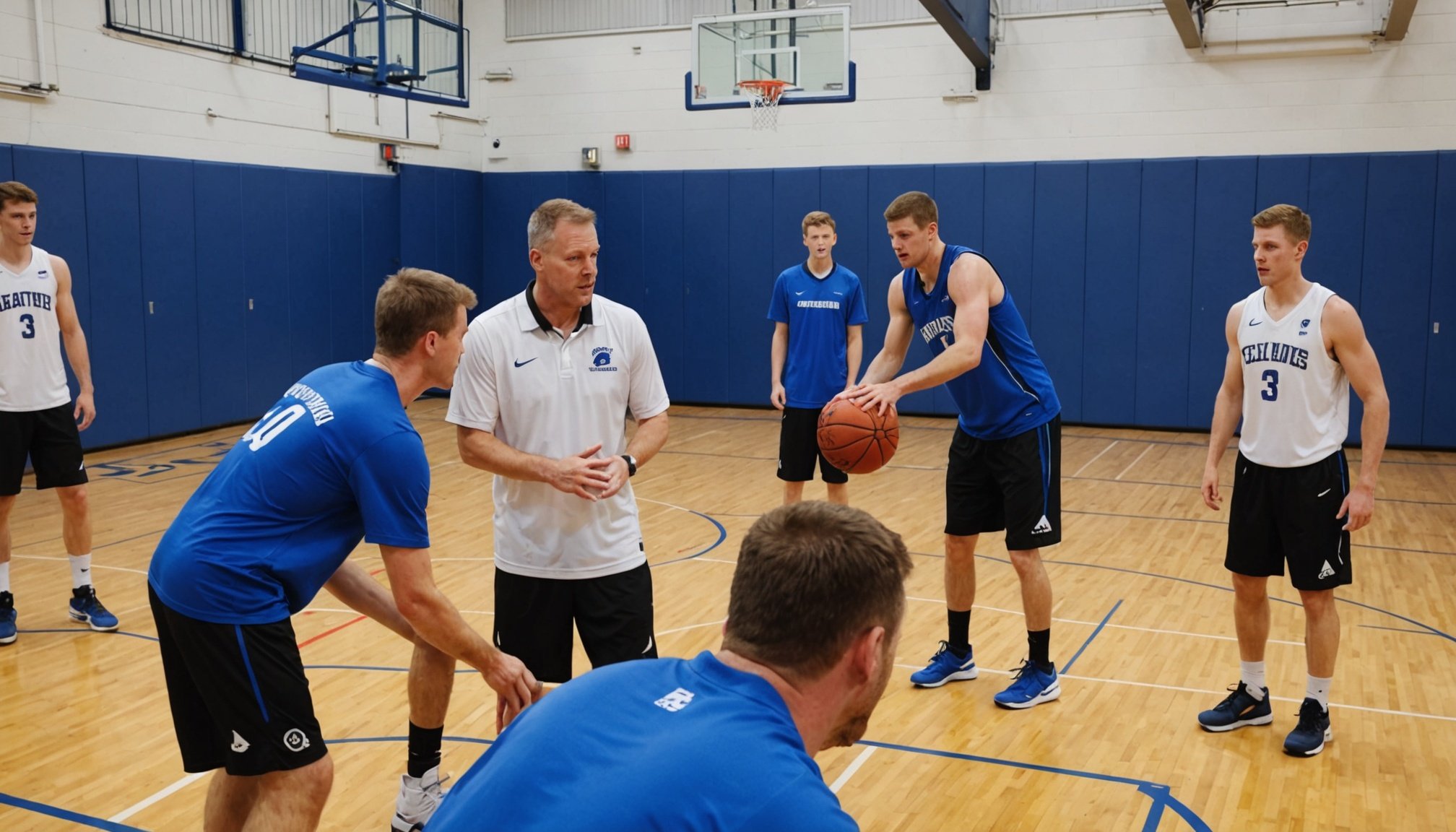Understanding High-Pressure Situations in Basketball
In basketball, high-pressure game scenarios are inevitable and can heavily influence the outcome of a match. Recognizing these moments is essential. They not only test players’ physical skills but also their psychological resilience. During these critical moments, the mental aspect can often eclipse physical abilities, as players experience heightened stress levels, affecting their performance.
The psychological impacts on players are profound during such situations. Anxiety can lead to poor decision-making, while confidence can significantly enhance performance. It’s crucial for players to develop mental strategies to handle stress and maintain focus. Techniques like mindfulness and visualization can be beneficial, offering players a way to manage stress and maintain concentration.
Also to see : Unleash your potential: the uk basketball player”s ultimate guide to mastering plyometric power
Coaches play a pivotal role in managing team dynamics under stress. By understanding player psychology and utilizing effective coaching strategies, they can foster a supportive environment. Coaches can implement drills mimicking high-pressure scenarios, allowing players to adapt to stress during training. Additionally, emphasizing teamwork and communication can help players remain composed and perform cohesively during high-stakes moments. This proactive approach not only improves individual player performance but strengthens the entire team’s ability to handle pressure effectively.
Innovative Drill Ideas to Enhance Readiness
In basketball, skill development hinges on effective drills that prepare players for real game situations. Integrating specific drills targeting competitive scenarios can fortify a team’s adaptability.
Also to discover : Mastering the paint: top rebounding drills for uk basketball centers to dominate the boards
Creative Shooting Drills
To simulate real-game stress, incorporate time constraints and score targets in shooting drills. Defensive pressure simulations can further enhance players’ ability to remain calm and composed. These methods encourage players to manage their mental state while maintaining effective shooting technique.
Situational Play Drills
Role-playing different game scenarios is crucial for developing adaptability. By mimicking various in-game situations, players sharpen their quick decision-making abilities. Encouraging them to respond swiftly to dynamic changes fosters a tactical mindset robust enough to withstand high-stakes games.
Defensive Strategy Drills
Focused defensive drills are vital for preparing players for late-game situations requiring heightened communication and teamwork. Emphasizing these aspects ensures players collaborate seamlessly. Techniques such as implementing rotational defenses and pressure zones cultivate anticipatory skills, pivotal in clutch moments.
By adopting such drills, coaches can significantly enhance a team’s preparedness, both physically and mentally, for the unpredictable nature of competitive basketball. These tabletop training exercises aim to fortify player resilience, equipping teams to tackle any high-pressure scenario effectively.
Psychological Preparedness Techniques
In the realm of basketball, developing mental conditioning is crucial for thriving in high-pressure situations. This involves not only physical readiness but also mental resilience. Players benefit from focus techniques like visualization, which can enhance their performance by mentally rehearsing successful plays. By envisioning themselves succeeding, players build confidence, reducing anxiety during critical game moments.
Mindfulness practices help players remain centred and keep their composure under stress. Techniques such as deep breathing can be practiced on and off the court, empowering players to maintain focus regardless of the game’s intensity. Coaches can introduce these techniques during training sessions, ensuring players are equipped with strategies to manage their mental state effectively.
Fostering a positive team culture also contributes to player confidence. Building a supportive environment where players feel safe to express themselves and learn from mistakes can lead to improved overall performance. Encouragement from teammates and coaches boosts morale, reinforcing mental resilience.
By prioritising these psychological preparedness techniques, coaches can help players develop a robust mental framework. This solid foundation not only supports individual performance during critical moments but also enhances the team’s ability to handle pressure collectively, creating a competitive edge.
Implementing Tactical Readiness
In basketball, refining game strategy is crucial for success in high-pressure moments. Anticipation skills form the backbone of tactical drills, preparing players for unforeseen challenges. Coaches should emphasise the importance of recognising game patterns, enhancing players’ ability to predict opponents’ moves.
Game-Film Analysis Sessions
Reviewing past games helps identify areas for improvement. Analysing game scenarios highlights patterns in players’ behaviours, particularly under pressure. By understanding these tendencies, players can learn effective responses to similar situations, improving overall strategical awareness.
Simulation of Game Scenarios
Conducting scrimmages under realistic, game-like conditions is vital. These sessions should focus on critical situational awareness and tactical execution. Emphasizing adaptability, players should practice making real-time decisions, reinforcing their confidence and preparedness.
Developing Individual Roles in Critical Moments
Clarifying each player’s role during key phases enhances team cohesion. Assigning specific responsibilities fosters confidence in decision-making, boosting players’ ability to execute under pressure. Consistent role play during training reinforces these responsibilities, ensuring players are equipped to handle late-game challenges effectively.
By integrating these tactical readiness techniques, teams can cultivate a proactive approach to high-pressure situations, fortifying players’ confidence and strategic aptitude.
Case Studies and Testimonials from Experienced Coaches
In the field of basketball coaching, real-life examples offer invaluable insights into effective techniques and strategies. Success stories abound, each highlighting the creativity and tenacity of coaches in navigating high-pressure situations. Consider a coach who implemented innovative drills that significantly improved their team’s performance in clutch moments. By sharing these stories, other coaches can glean best practices to enhance their own methods.
Lessons learned from these high-pressure experiences reveal the importance of adaptability. Coaches often recall the necessity to adjust strategies in response to their team’s specific needs. These testimonials underscore the role of personalised approaches in fostering player psychology and confidence during intense games.
Maintaining player composure is another critical lesson echoed through numerous experiences. Experienced coaches stress the significance of mental conditioning, illustrating how developed resilience becomes the team’s backbone under stress. Insights from seasoned professionals demonstrate that a calm, focused mindset can pivot the game’s outcome.
Through rich coaching experiences, these stories provide a roadmap to success, offering both inspiration and practical guidance. By embracing the collective wisdom of experienced coaches, teams can bolster their ability to thrive under pressure.
Visual Aids and Additional Resources
Providing visual aids and additional resources can significantly enhance a coach’s ability to convey complex concepts and drills effectively. These tools serve as essential guides in translating theoretical strategies into practical applications on the court.
Diagrams for Key Drills
Diagrams offer a visual breakdown of complex drills, laying out each component in an easy-to-follow format. These graphical representations help coaches convey intricate strategies clearly, ensuring players grasp their responsibilities during practices. Step-by-step guides accompany these diagrams, instructing coaches on implementing each drill’s component systematically, reinforcing player comprehension, and execution.
Links to Video Demonstrations
Curated video demonstrations provide an invaluable opportunity for visual learning. Watching these videos helps coaches and players see strategies in action, bridging the gap between theory and practice. They serve as an excellent supplement to in-person training by illustrating proper form and technique.
Recommended Reading and Further Learning
Exploring books and articles focused on coaching under pressure offers in-depth insights into basketball coaching intricacies. Incorporating such resources enriches a coach’s toolkit, introducing varied perspectives and techniques. Engaging in online courses or workshops can further develop a coach’s understanding, equipping them with up-to-date knowledge and skills in the evolving landscape of basketball.











